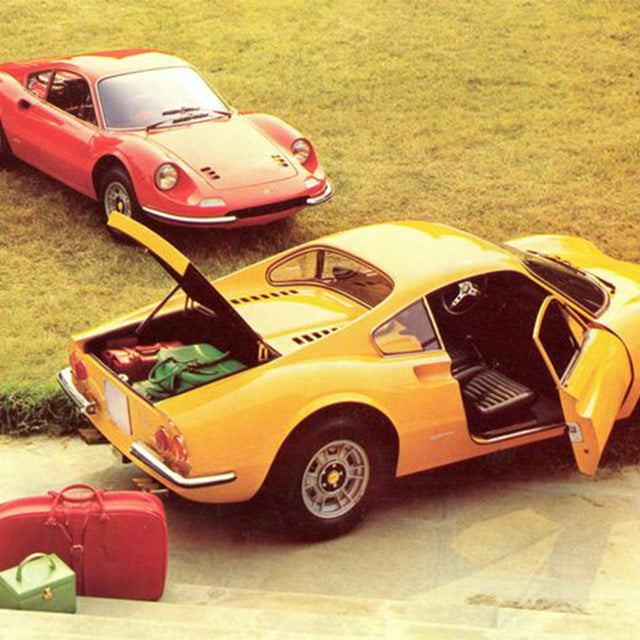Among this fluctuating catalog of madness, though, is a static inventory of machines that have earned their way into my heart via their beauty of form and engineering, these far more noble attributes unaffected by my frequent, temporary bouts with automotive insanity—novelties are fun, but classics never lose their core appeal. High atop this personal list of “all-time” cars is the Dino 246, a Ferrari in part and a legend in whole.
Alfredo Ferrari, first son of Enzo, was born in Modena in the first month of 1932. So touched was Ferrari by little Dino’s arrival that he immediately swore off the physical task of driving competitively, which he was still deeply involved with under the banner of his Scuderia Ferrari, Alfa Romeo’s factory racing team of the era. After many successful years in this role, Enzo would leave under a cloud after a 1939 falling out with management, before founding Ferrari S.p.A. around the time of Dino’s 15th birthday in 1947.
Long before family business was family empire, Enzo intended for his son to one day succeed him as Il Commendatore of Ferrari, and began grooming him to do so from a very young age. Dino attented the finest schools in Europe with a strong focus on industrial finance, broader economics, and of course, engineering. It quickly became apparent, however, that Dino was not well, and by the time he had completed only two years of technical school he was forced to withdraw for health reasons—this never stopped his father from calling him his “engineer son”, however.
Though his exact level of involvement is disputed, Dino is said to have had a hand in several key Ferrari designs, notable the 750 Monza and several small-capacity racing V6s. At the tragically young age of 24, Dino fell victim to what is now known as Muscular Dystrophy, passing away in June of 1956. Enzo was devastated, as was his wife Laura, with whom he never quite reconciled afterwards. The Dino series of racing cars, as well as the 206/246 and their successors were named in honor of his departed son.



Released in 1968, and with only 152 every built, the 206 GT was the first road-going Dino. As a stand-alone brand, Dino was initially intended for Ferrari-designed cars with less than twelve cylinders, which at the time was seen by Enzo as an essential part of his brand’s DNA. Though technically not a Ferrari, the 206 was nonetheless Maranello’s first mid-engined road car. Its replacement would soon add “first mass-produced car” to the list of the brand’s milestones.
Built from 1969-1974 in much greater numbers, nearly 25 times as many 246s were made compared to its smaller-engined older brother. Building upon the theme laid by the 206, the 246 was compact, light, lithe, and packed with the period’s most cutting-edge technology; four wheel disc brakes, fully independent suspension at all corners, and a high-revving, twin cam per bank 2.4 liter V6 making just under 200 HP in European spec, with about twenty less for the American market due to primitive smog equipment. Like the 206 which pioneered it, the 246 retained electronic ignition by Magnet Marelli.
Both cars looked quite similar, which is to say drop-dead gorgeous. The 246 was roughly 5-10% larger in most dimensions, though still by no means a large car. Styled by Pininfarina, their sensuous, organic curves may have been of a style typical of the time, but the perfection of their execution was anything but. Graceful forms and elegant detailing are not uncommon features among the kind of rare and exotic classics we all lust for, but it’s very rare for these words to describe a machine in its entirety—a 246, particularly in coupe form, is visual perfection from every angle.
I’ve not had the pleasure of driving one, and with prices rising exponentially over the past few years, I may never, but that doesn’t stop me from dreaming about it. I’ve read varying, conflicting accounts of how a 246 feels in the hands, feet, and butt of a driver—some claiming the car to be a reluctant dance partner—all heavy, lifeless steering, understeer snapping into roll oversteer, and gutless low-end power delivery, while others have written the exact opposite of these things, proclaiming the second-ever Dino to be a driving revelation… but here’s how it goes down in my imagination:
It steers with alacrity, the small leather rim fizzing with friendly conversation, the little bent six revving with a happy, inertia-free vigor; clutch, brakes, and throttle all feel carefully weighted and delicately light of touch, the open-gated five speed equally deft and precise. I close my eyes and feel the aplomb with which it rides the road, like a Silver Cloud with slightly seized dampers or a single flat tire, its cornering balance neutral and easily manipulated by an accurate and immediately responsive throttle.
The sound, in keeping with the shape it emanates from, is heavenly—two indisputable facts to go along with a lot of conjecture, both in and of themselves valid reasons for the 246’s greatness, even if they actually do drive like a wet dog.



Photo Sources:e-carpictures.com ,carstyling.ru ,haris300.tumblr.com ,boldride.com ,ferraricollection.eu ,ebay.com , carbodydesign.com ,findagrave.com




















































